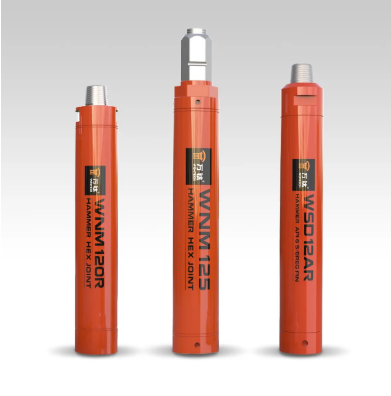延長ロッドの理解について 掘削 応用
延長ロッドとは何ですか?
延長ロッドは、ドリルビットと動力源の間のコネクターとして機能し、掘削作業において重要な役割を果たします。基本的にこれにより、作業者は工具をあらゆる素材の奥深くまで届かせることができ、標準的な掘削機器を町中でのさまざまな作業において非常に役立つものにしています。ビットに正しく接続されたこれらのロッドは、通常のドリルでは困難になる障害物を突破する助けとなります。建設作業員、鉱山労働者、配管工などは、深く掘り進む必要があるプロジェクトにおいて、この追加の到達距離に依存しています。ただし、このような状況において本当に重要なのは単に深くまで到達することだけではありません。地下での作業を正確に制御することも同様に重要です。延長ロッドは単なる掘削深度の拡大以上に、この点で優れた性能を発揮します。これにより専門家は、状況がわずかに変化するたびにすべての工具セットを取り替えることなく、複数の種類の掘削作業を柔軟に対応できるようになります。
なぜ適切な選択が重要か 掘削 効率
正しい延長ロッドを選ぶことで、ドリルの作業効率が大きく向上し、無駄なエネルギー消費を抑え、機器の寿命を延ばすことができます。作業者が自身のニーズに合ったロッドを選べば、作業速度や穴の精度において実際に良い結果が得られます。現場からの一部の報告では、高品質な延長ロッドを使用することでドリル速度が約30%向上する場合があり、これによりプロジェクトが早く終了し、チームが無駄に時間を待つことも減少します。高品質に作られたロッドは安価な代替品よりも耐摩耗性に優れているため、ロッド自体だけでなく接続する機械も長持ちし、頻繁な修理を必要としません。現場で作業する人にとっては、替え品にかける費用を抑えることができながらも、毎日安定した作業が行えるということになります。
延長ロッドを選ぶ際の重要な考慮事項
素材の耐久性: 鋼対カーボンファイバー
適切な延長ロッドを選ぶためには、まず素材の耐久性について理解することが重要です。鋼鉄製のロッドは、建設現場や機材が酷使される鉱山など、過酷な環境でも簡単にはへこたれないため、特に目立ちます。日々の過酷な作業に耐える必要がある現場では、鋼鉄製のロッドはあらゆるダメージに耐えられるため理にかなっています。一方、カーボンファイバー製は全く異なる特徴を持っています。それは鋼鉄よりもはるかに軽量であり、長期間使用しても錆びることはありません。軽量なロッドは長時間の作業においても取り扱いが容易で、背中に余計な負担をかけずに済むため、多くの作業員が好んで使用しています。最も経験豊富な専門家は、圧力に耐えて長持ちする素材として依然として鋼鉄を推奨していますが、航空機メンテナンスや海洋掘削の分野では、重量が重要であり、腐食が許されない環境であるため、カーボンファイバーを好む声も少なくありません。
異なる場合の長さの要件 掘削 深度
適切な長さの延長ロッドを選ぶことは、さまざまな作業におけるドリル性能に大きく影響します。基本的に、作業内容に応じて必要な掘削深度にロッドの長さが合っていなければならず、これにより作業がスムーズかつ正確に行われます。多くの業界では、一般的に使用されるロッド長さに関する決まりがあります。例えば、建設業界と配管業界では、壁の構造と配管の設置方法が異なるため、必要とされる深度も全く異なります。プロのドライラーは、機器メーカーが公表するガイドラインに従うのが一般的で、そこにはさまざまな用途に応じた標準的な長さが記載されています。これにより、作業者は推測するのではなく最適な選択ができ、時間の節約にもなり、後工程での高価なミスを避けることができます。
ドリルビットシャンクサイズとの互換性
延長ロッドとドリルビットシャンクの適切な適合は、作業中に機器の故障を避けるために非常に重要です。それらのロッドがドリルビットの仕様と正しく合致しない場合、作業が正常に進みません。多くの作業場では現在、標準的なシャンクサイズを使用しているため、定期的にドリル作業を行う人にとって、どのサイズがどこに適用されるかを把握しておくことが非常に重要です。ここで適合が合わないと、工具の損傷から作業現場での危険状態まで、様々な問題が生じる可能性があります。そのため、経験豊富な技術者は、延長ロッドとビットを併用する作業を始める前に、常に寸法を二重に確認します。
トルク容量と安定性
延長ロッドのトルク容量は、掘削作業の効率性において本当に差を生みます。これは伝達される動力の量に影響を与えるだけでなく、作業中の安定性も左右します。トルクの仕様をよく見極めることが重要なのは、特定のロッドがさまざまな作業負荷に耐えられるかを判断するためです。多くの経験豊富な技術者は、作業に必要なトルクに応じてロッドを選定することを強調します。これに注意を払うことで、ドリル作業地点での安定性が向上し、機器の故障による中断も減少します。作業者が自身のトルク要件を実際の現場条件に合わせて選ぶことで、大規模・小規模を問わず、プロジェクト全体を通して掘削作業がよりスムーズで一貫したものになります。
延長ロッドの種類とその使用例
精密作業用のねじ式延長ロッド
ネジ付き延長ロッドは、非常に狭い公差が要求される作業のために特別に設計されています。ネジ付き延長ロッドが優れている点は、ドリルビットを確実に固定する精密に機械加工されたネジによって、振動を抑え、穴あけ中にすべてを正確に位置づけた状態に保つことができる点です。このような精度は、航空宇宙産業や自動車製造業において特に重要であり、数分の1インチ単位での測定が求められる場面では、単に望ましいだけでなく絶対的に必要とされます。例えば航空機の組立では、こうしたロッドによって重要なコンポーネントを確実に固定することができます。自動車部品の製造においても同様で、ほんのわずかな誤差が後に大きな問題を引き起こす可能性があります。工場がネジ付き延長ロッドを採用することで、すべての生産工程において安定した結果を得ることが可能です。品質に対する期待が高まる中で、部品が一貫して厳しい業界規格を満たし続けることは、ますます重要になっています。
素早いビット交換用クイックコネクトロッド
建設現場やメンテナンス作業エリアで忙しいドリル作業を行っている人々にとって、クイックコネクト延長ロッドは状況を大きく改善します。この設計は作業を簡便かつ迅速に行えるように焦点を当てており、作業者は素早くドリルビットを交換できるだけでなく、すべてを確実に接続したままに保つことができます。これらのロッドが最も得意とするのは、作業の合間に発生する無駄な時間を削減することで、特に時間単位で成果が左右される状況において、全体的な生産性の向上に繋がります。多くの請負業者は、これらのロッドへの切り替えによって作業がどれほど楽になったかを語っています。例えば、1日の作業中に数十回ものビット交換が必要だった大規模な建設プロジェクトでは、作業が大幅に遅れてしまうことがありました。しかし今では、別のビットが必要になっても作業を止めなくてもよくなったのです。このため、状況の変化に迅速に適応する必要がある多くのプロフェッショナルが、伝統的な方法よりもクイックコネクトシステムの使用を好むのです。
角度ドリル用のフレキシブル延長ロッド
柔軟な延長ロッドは、狭い場所でも角度をつけてドリル作業ができるため、スペースが限られた現場ではほぼ必須の工具といえます。これらの工具の特徴は、障害物を実際に曲がりくねって通り抜けられる点であり、誰もが避けたいと思うような無理な位置でも正確な穴あけが可能です。配管工は、既存のパイプを壊さずにさまざまな配管の中を這わせることができるので重宝します。電気工事士にとっても同様の利点があり、特に間取りの変わった古い建物に配線を通す際に役立ちます。これらのロッドの真価は、わずかな調整のために大がかりな解体工事を避けることができる点にあり、時間と費用を節約できます。派手さはありませんが、狭いスペースで作業する人であれば、日々の作業においてどれほどの違いを生むかをよく知っています。
適切な延長ロッドを選択することは、あなたのドリル作業において非常に重要です。ネジ式、クイックコネクト、およびフレキシブルロッドのそれぞれの利点を理解することで、特定のプロジェクト要件に最適な選択ができます。
揺れと滑りを防ぐための設置のポイント
ドリル作業中に不要な動きを止めるには、実際にセットネジやロック機構を正しく取り付けることが非常に重要です。部品が緩んでしまえば、全体のドリル装置は十分な性能や精度を発揮できません。現場で最も効果的な方法は、まずご使用のロッド径に合ったセットネジを特定し、次に製造元の仕様に従って適切な締め付けトルクをかけることです。時折、軽く引いてみるテストによってネジの状態を確認することも忘れないでください。多くの工具メーカーはマニュアルに各ネジの正しい位置を示したわかりやすい図を掲載しています。このような図解は、機械を正しくセットアップして、後々の運用中に部品のずれによるトラブルを避けるために非常に役立ちます。
延長ロッドとドリルチャックを正しくアラインメントすることが、スリップを防ぎ、すべてを正しく作動させるために非常に重要です。物事が正しく整列していないと、ドリル作業はせいぜい非効率的になり、最悪の場合非常にイライラするものになります。全体のプロセスが正確さを失い、さらに悪いことに、機器が長期間にわたって損傷を受ける可能性があります。では、これをどう解決すればよいのでしょうか?まずチャックをロッドに当て、それらを直線になるまで調整してください。多くの最新のチャックには視覚的な確認を容易にするアラインメントマークが内蔵されています。全体のセットアップを周囲からも確認することも忘れないでください。小さな隙間や奇妙な角度が、私たちが気づかないうちに問題を引き起こしているかもしれません。こうした基本的な手順に従っていれば、ほとんどのアラインメントに関する問題は解消され、スムーズで信頼性の高いドリル作業が毎回可能になります。
安定器のアタッチメントは、振れを抑え、必要なサポートを提供するため、困難な掘削作業において大きな違いを生みます。これらの小さな補助具は基本的に全体のシステムを剛性化するため、オペレーターがより真っ直ぐに、またビットの進む方向をより正確に制御できるようになります。安定器を検討する際は、まず既存の機器と正しく適合するか確認し、次に必要な作業に合った耐荷重仕様を調べてください。正しく作動させるためには、それらのアタッチメントをメインユニットにしっかりとボルト固定し、作業中に接地する面が水平を保つことを再確認してください。多くの経験豊富なドリラーが言うには、長時間のシフト後や異なる素材への切り替え時に、数時間ごとに安定器を点検することが理にかなっているとのことです。
メンテナンスと安全のベストプラクティス
スレッドの定期的な清掃と潤滑
延長ロッドを長期間使用し、正しく作動させるためには、メンテナンスが重要です。ロッドが正常に作動するためには、ネジ山を清潔に保ち、適切に潤滑しておく必要があります。まずは柔らかい布などでネジ山の汚れや油汚れを丁寧にブラッシングして除去してください。次に、中性洗剤を水で薄めた液を使い、ネジ山をしっかりと拭き取ります。洗浄後は、金属用の潤滑剤を忘れずに塗布して、錆の発生を防ぎ、今後の調整を容易にします。これらの工程を怠ると、後々問題が発生する可能性があります。定期的なメンテナンスにより、ロッドの寿命を大幅に延ばすことができ、実際にドリリング作業が必要なときに部品が固着したり、作動不能になるといったトラブルを未然に防ぐことができます。
摩耗や構造的な損傷の点検
延長ロッドを定期的に点検することは、それらの安全性や信頼性に影響を与える摩耗部分や構造上の問題を発見するうえで大きな違いをもたらします。点検中は、ネジの状態を確認し、ヒビ割れの兆候を調べ、ロッド全体をくまなくチェックして曲がりや変形がないかを確認してください。小さな損傷でも時間が経つにつれて弱い部分がより大きな問題へと発展し、作業中に問題が発生する可能性が高くなるため、見逃さないようにすることが重要です。多くの専門家は、少なくとも3〜4か月に1回は点検することを推奨していますが、頻繁に使用する場合は毎月の点検が望ましいでしょう。潜在的な故障を未然に防ぐことは、長期的にはコスト削減につながり、突然の危険な状況を防ぐことにもなります。
高トルクアプリケーションのための安全プロトコル
高トルクのドリリングに延長ロッドを使用する際には、安全が最も重要です。適切な安全手順を守ることで事故のリスクを大幅に軽減できます。作業者は飛散する破片や作業中のロッドの突然の動きから身を守るため、手袋や保護めがねなどの適切な防護具を着用する必要があります。作業を始める前に延長ロッドと既存のドリル部品の適合性を確認してください。部品の不一致がシステム内のどこかに過度な負荷を引き起こす可能性があります。業界の安全団体は多くの場合、ハーネスの着用および作業区域の適切な確保を推奨しています。これらの基本的な予防策は職場の安全性を高めるだけでなく、現実の作業条件下で高トルク作業の実際の作業効率を向上させる傾向があります。
よくある質問
-
延長ロッドは何に使いますか?
延長ロッドは、ドリルビットの到達範囲を延ばすために使用され、より深い貫通を可能にし、建設、採鉱、給排水工事などさまざまな用途で適応性を提供します。
-
プロジェクトに適した延長ロッドを選択するにはどうすればよいですか?
材質の耐久性、長さの要件、ドリルビットのシャンクサイズとの互換性、そしてトルク容量などの要素を考慮し、特定のニーズに合った延長ロッドを選択してください。
-
スレッDED延長ロッドを使用するメリットは何ですか?
スレッド付き延長ロッドは精度が高く、安定しており、振動が少ないため、航空宇宙や自動車製造など正確な仕様が必要な産業に最適です。
-
ドリリング中に揺れや滑りを防ぐことがなぜ重要ですか?
揺れや滑りを防ぐことは、作業効率と精度を維持し、機器の損傷を回避し、正確な操作を確保するために重要です。
-
延長ロッドにはどのようなメンテナンスを行えばよいですか?
定期的にスレッドを清掃し、潤滑剤を塗布し、摩耗や構造的な損傷を点検し、特に高トルクのアプリケーションでは安全プロトコルに従ってください。

